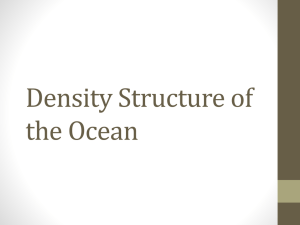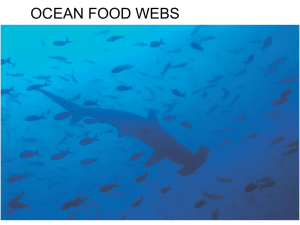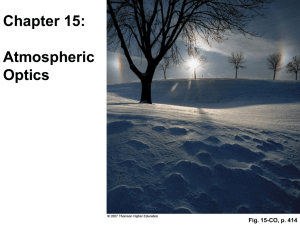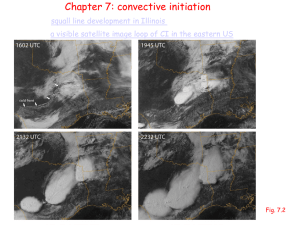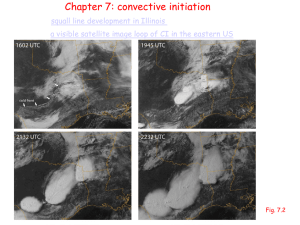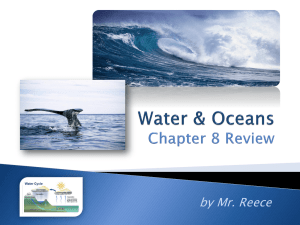bio2MarineCH3
advertisement
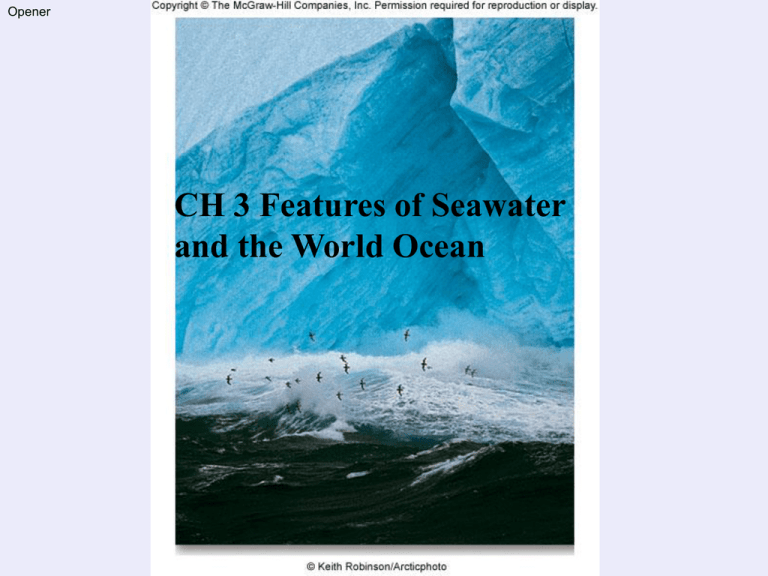
Opener CH 3 Features of Seawater and the World Ocean Fig. 3.4 Waters of the Ocean •Earth •only planet with liquid water on its surface •80% or more of our bodies •Water cycle (condensation, precipitation, evaporation) Properties of Water •Arrangement of its atoms •Nature’s solvent •Covalent and hydrogen bonds •Polar properties •Cohesion •Adhesion •Heat storage Water exists naturally on Earth in all three states •Hydrogen bonding •Regulates global temperatures Density of water • Density increase as temperature decreases – 40 C or 390 F • Below this density decreases as water freezes • Ice floats on water Salinity • Amount of dissolved solids in ocean water – 35 grams of dissolved solids/kg of ocean water – Ranges from brackish to hypersaline • 6 ions – Chloride, sodium, sulfate, magnesium, calcium, and potassium – Constant proportion to each other Physical Properties of Pure Water vs Salt Water • Salt water •Higher in pH (basic) •More dense •Higher boiling point •Lower freezing point Seawater • Dissolved components are added and removed by variety of processes o Precipitation o Runoff o Melting of icebergs and sea ice o Evaporation Fig. 3.6 Salinity, Temperature, and Density • Salinity of surface water varies considerably due to surface processes – Maximum salinity found near tropics – Minimum found in high – latitude regions • Halocline – Layer of rapidly changing salinity – Deeper waters more constant • 1000 meters Fig. 3.7 Seawater Density • Density increases as temperature decreases and salinity increases • Pycnocline – Rapidly changing density in low – latitude regions • Thermocline – Rapidly changing temperature in high – latitude regions Fig. 3.9 Fig. 3.10 Temperature of the ocean; coldest in blue, warmest in red Dissolved Gases •Oxygen, Carbon Dioxide, Nitrogen •Cold water vs warm water •Oxygen affected by the rate of photosynthesis •Carbon Dioxide represents 80% of the dissolved gas in the ocean Transparency •Sunlight can penetrate into the ocean o Photosynthesis o ROY G BIV •As depth increases colors are filtered out •Only blue light remains approx 200ft •Affected by material suspended and dissolved in the water Fig. 3.11 Fig. 3.12 At 30m only blue light remains, (a) natural light (b) flash Pressure •Changes with the water depth •All the weight from above pushing down •Pressure increases with depth o For every 33ft = 1 atmosphere of pressure o (1 atm = 14.5 lbs. /sq. ft) Fig. 3.14 Fig. 3.15 Reverse effect of pressure for deep sea creatures being brought to the surface. Critical Thinking • In unusually cold winters the northern Black Sea sometimes freezes while the nearby Adriatic Sea usually doesn’t, even if it is just as cold. Freshwater runoff gives the surface of the Black Sea a low salinity of about 180/00 . What would you guess about the salinity of the Adriatic? Ocean Circulation •Transports; •heat, nutrients, pollutants, and organisms •Surface Circulation •Wind driven is the strongest •Driven by the sun (thermal) Fig. 3.16 Earth’s rotation causes an arc in the movement of currents Coriolis Effect •Nonlinear movement of currents •Right or clockwise in the Northern Hemisphere •Left or counterclockwise in the Southern Hemisphere Wind Patterns Affect on Currents •Heat energy •Equator is warmer than the poles 1. Air is heated 2. Less dense and begins to rise 3. Air gets pulled into pocket • curved at an angle due to Coriolis Effect. Fig. 3.17 Fig. 3.18 Surface Currents •Wind push sea surface creating currents o Surface water moves at an angle from the wind o Pushes layer of water below moving it at an angle o Continues to move down the water column resulting in a spiral (Ekman spiral) Fig. 3.19 Fig. 3.20 Main ocean basin currents combine to form wind – driven gyres. Global Wind Patterns •Regulate the earth’s climate o Transporting heat from tropical to polar regions •Affect the distribution of organisms •Currents shift with the season or weather Thermohaline Circulation and the Great Ocean Conveyor •Ocean is a 3 – dimensional habitat •Densest water sinks creating layers (stratified) •Dense water on bottom and least dense at the surface Fig. 3.21 3 – Layered Ocean/Thermocline •Surface layer – approx. 660ft thick. o Mixed by wind, waves, and currents. o Can be heated and warmer than deeper water • Intermediate Layer • Deep or Bottom Layer Fig. 3.22 Seasonal changes in surface temperature can change density of water causing surface water to sink, known as downwelling. Fig. 3.24 Fig. 3.25 Great Ocean Conveyor as a result of changes in water temperature and salinity. Critical in regulating earth’s climate. Just for Fun • Someone in Beaufort, South Carolina, throws a message in a bottle into the sea. Some time later, someone in Perth, on the west coast of Australia, find the bottle. Referring to fig. 3.20 and the fold – out map at the back of your textbook, trace the path the bottle probably took?


